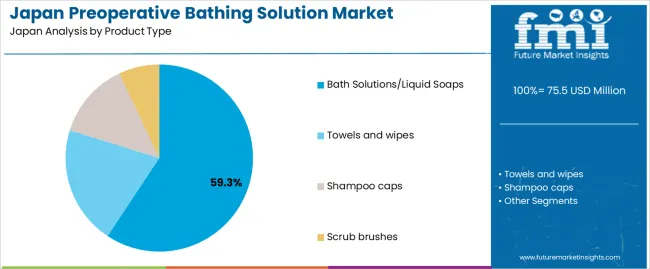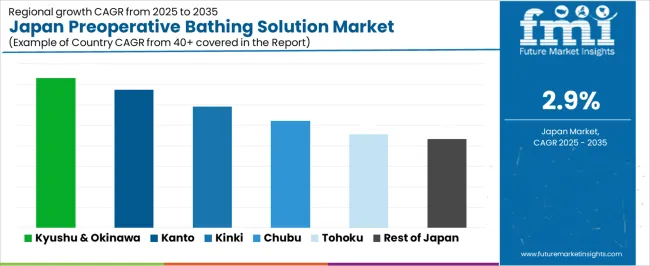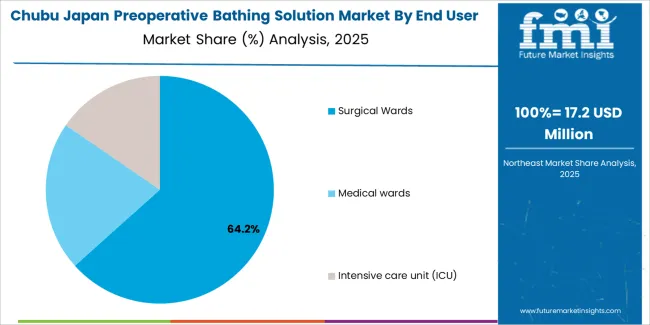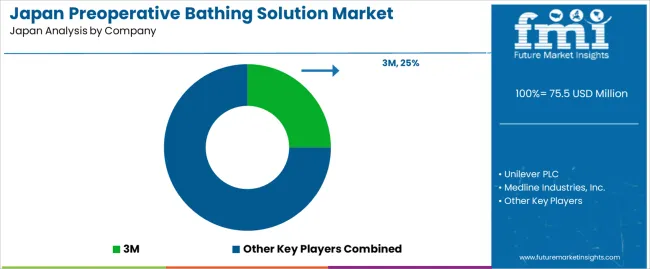The demand for preoperative bathing solutions in Japan is valued at USD 75.5 million in 2025 and is projected to reach USD 100.7 million by 2035, reflecting a compound annual growth rate (CAGR) of 2.9%. This steady growth is driven by the increasing focus on infection control and improving patient outcomes in surgical settings. Preoperative bathing solutions, including antiseptic and antimicrobial products, help reduce surgical site infections and are becoming an integral part of pre-surgical protocols across hospitals and surgical centers. As the healthcare system places more emphasis on patient safety and hygiene, the demand for these solutions is expected to rise gradually.
The market shows stable, incremental growth over the forecast period, with year-on-year increases from USD 65.4 million in earlier years to USD 75.5 million by 2025, continuing to USD 100.7 million by 2035. The growth pattern exhibits minor fluctuations, with slight changes in growth rates between years. For example, the growth rate fluctuates between 2.8% and 3.0%, indicating slight acceleration and deceleration throughout the period. These fluctuations suggest that while the overall market trend remains positive, there are mild variations in growth momentum due to changes in healthcare protocols and seasonal factors influencing adoption rates across different periods.

Demand in Japan for preoperative bathing solutions is projected to increase from USD 75.5 million in 2025 to USD 100.7 million by 2035, reflecting a compound annual growth rate (CAGR) of approximately 2.9%. From USD 65.4 million in 2020, demand rises steadily each year, reaching USD 75.5 million in 2025. Between 2025 and 2030, demand will grow from USD 75.5 million to USD 84.7 million, driven by increasing surgical volumes, higher adoption of hygiene standards, and the integration of antiseptic bathing solutions in preoperative procedures. By 2035, demand is expected to reach USD 100.7 million, supported by stronger hospital protocols, rising healthcare awareness, and improvements in antiseptic formulations that enhance pre-surgical care.
The absolute dollar opportunity in this industry is projected to be USD 25.2 million, representing the difference between USD 75.5 million in 2025 and USD 100.7 million in 2035. During the first half of this decade (2025–2030), the demand will increase by USD 9.2 million, accounting for 36% of the total forecasted growth. The remaining USD 16.0 million opportunity is expected to occur between 2030 and 2035. As the market matures, the bulk of the growth will come from incremental improvements in preoperative protocols, resulting in greater adoption of specialized antiseptic bathing solutions. This steady increase over the forecast period presents clear growth opportunities for stakeholders in the healthcare sector.
| Metric | Value |
|---|---|
| Industry Value (2025) | USD 75.5 million |
| Forecast Value (2035) | USD 100.7 million |
| Forecast CAGR (2025 to 2035) | 2.9% |
The demand for preoperative bathing solution in Japan is shaped by a growing emphasis on infection control practices within surgical care. As the number of surgical procedures increases in Japan, healthcare providers seek reliable methods to reduce microbial load on the skin before incision. Preoperative bathing solutions are used in surgical wards and intensive care units to support hygiene protocols and patient preparation routines. Hospitals in Japan are increasingly adopting such solutions as part of standard pre surgery workflows in order to minimise the risk of postoperative complications and align with clinical guidelines. The prevalence of aging patients and a busy surgical schedule contribute to the need for preoperative skin preparation solutions across care settings.
Another factor supporting demand is the push toward more outpatient and same day surgical services in Japan’s healthcare system. In settings where patients may prepare at home or arrive shortly before surgery, ready to use bathing solutions allow for convenient preoperative skin cleansing, reducing prep time in the hospital. Hospitals and clinics also replace older methods with products designed for ease of use and standardized application, thereby strengthening the uptake of preoperative bathing solutions. Cost management remains a consideration, but the integration of these products into hospital procurement and surgical preparation protocols supports sustained growth of demand in Japan.
The demand for preoperative bathing solutions in Japan is influenced by both the product type and the end-user segments. Product types include bath solutions/liquid soaps, towels and wipes, shampoo caps, and scrub brushes, each serving different needs in the preoperative preparation process. End-users of these solutions include surgical wards, medical wards, intensive care units (ICUs), and other hospital departments that require hygienic protocols to prevent infections before surgery. These segments reflect the emphasis on infection control, patient preparation, and maintaining high hygiene standards in healthcare settings.

Bath solutions/liquid soaps account for 59% of the total demand for preoperative bathing solutions in Japan. This product type is in high demand due to its effectiveness in cleansing the skin and reducing the risk of postoperative infections. Liquid soaps are commonly used in preoperative settings to ensure that patients are thoroughly sanitized before surgery. The demand for bath solutions is also driven by their convenience, ease of use, and widespread application across various surgical and medical procedures.
The preference for liquid soaps is further supported by Japan's strict infection control standards and the healthcare system's focus on patient safety. Bath solutions are an integral part of preoperative care protocols, helping to eliminate bacteria and other pathogens on the skin to reduce the risk of surgical site infections. As hospitals continue to prioritize hygiene and infection prevention, the demand for bath solutions and liquid soaps will remain strong in Japan's healthcare environment.

Surgical wards account for 62.9% of the total demand for preoperative bathing solutions in Japan. This high demand is primarily driven by the critical role surgical wards play in patient preparation before procedures. Preoperative bathing is an essential step in ensuring that patients are clean and free of pathogens, reducing the risk of infection during surgery. Surgical wards in Japan adhere to stringent infection control practices, which include the use of effective preoperative bathing solutions to ensure patient safety and optimal surgical outcomes.
The demand for preoperative bathing solutions in surgical wards is also influenced by the increasing number of surgeries being performed in Japan, particularly as the aging population requires more surgical interventions. As surgical wards remain central to the preoperative process, the need for efficient, reliable bathing solutions continues to grow, ensuring that patients are properly prepared for surgery. This demand is expected to increase as the focus on infection prevention and patient care in surgical settings intensifies.
The demand for preoperative bathing solutions in Japan is increasing due to heightened focus on infection prevention and surgical site infection (SSI) reduction. With the country’s healthcare system prioritizing patient safety and infection control, more hospitals are adopting antiseptic preoperative bathing protocols. The growing number of elective surgeries, especially in outpatient and smaller medical settings, is further driving demand. However, challenges like cost, the need for proper reimbursement policies, and varying adoption rates across institutions pose barriers to widespread usage.
How is the growing focus on infection prevention influencing the demand for preoperative bathing solutions in Japan?
In Japan, the heightened emphasis on infection prevention, particularly surgical site infections (SSIs), is a major factor driving the demand for preoperative bathing solutions. Medical guidelines increasingly recommend pre-surgical antiseptic bathing to reduce microbial load on patients' skin, which has led to more hospitals and clinics adopting these solutions. This growing awareness around infection control, combined with rising surgical volumes, particularly in outpatient care, is creating a favourable environment for preoperative bathing solution providers.
What Opportunities Exist for Preoperative Bathing Solutions in Japan’s Smaller Healthcare Facilities?
A key opportunity for preoperative bathing solutions in Japan lies in expanding use in smaller hospitals and outpatient surgical centers. These facilities often lack comprehensive infection control systems, making them prime candidates for preoperative bathing products. Additionally, as Japan’s healthcare system faces increasing demand for outpatient surgeries, there is growing potential for these solutions to be incorporated into standard practices for elective procedures. Cost-effective, easy-to-use bathing solutions that align with existing workflows could see significant adoption in these settings.
What Barriers are Limiting the Widespread Adoption of Preoperative Bathing Solutions in Japan?
Several barriers are slowing the adoption of preoperative bathing solutions in Japan. One significant challenge is the cost of specialized bathing products, which can be prohibitive for smaller institutions or those with tight budgets. Additionally, the varying implementation of infection control guidelines across medical facilities and inconsistent reimbursement policies hinder broader adoption. Some healthcare providers are also skeptical about the actual benefits of preoperative bathing solutions, especially in relation to standard bathing methods, which can further delay implementation.

| Region | CAGR (%) |
|---|---|
| Kyushu & Okinawa | 3.7% |
| Kanto | 3.4% |
| Kinki | 3.0% |
| Chubu | 2.6% |
| Tohoku | 2.3% |
| Rest of Japan | 2.2% |
The demand for preoperative bathing solutions in Japan is experiencing steady growth across regions. Kyushu and Okinawa lead with a 3.7% CAGR, driven by increasing awareness of infection prevention and a growing emphasis on hygiene in healthcare settings. Kanto follows at 3.4%, supported by advanced medical facilities and high adoption of infection control protocols. Kinki records 3.0%, influenced by established healthcare systems and rising demand for effective surgical preparation solutions. Chubu grows at 2.6%, with moderate demand in regional hospitals. Tohoku experiences a 2.3% growth, while the rest of Japan shows a 2.2% increase, reflecting gradual adoption of preoperative hygiene practices across smaller healthcare facilities.
Kyushu & Okinawa is projected to grow at a CAGR of 3.7% through 2035 in demand for preoperative bathing solutions. The region’s healthcare system, particularly in urban areas like Fukuoka, is increasingly adopting preoperative care protocols to enhance patient safety and reduce surgical site infections. With the rise in elective surgeries and increased focus on infection prevention, healthcare providers in Kyushu & Okinawa are emphasizing the importance of antimicrobial bathing solutions. The region’s growing healthcare infrastructure further drives the adoption of these solutions for pre-surgical hygiene.

Kanto is projected to grow at a CAGR of 3.4% through 2035 in demand for preoperative bathing solutions. As Japan’s economic and healthcare hub, Kanto, particularly Tokyo, leads in adopting preoperative hygiene protocols to reduce the risk of surgical site infections. With the increasing number of surgeries, both elective and emergency, healthcare facilities in the region are incorporating preoperative bathing solutions as part of their infection control measures. The rising awareness among healthcare providers and patients about the importance of pre-surgical hygiene further contributes to this demand.
Kinki is projected to grow at a CAGR of 3.0% through 2035 in demand for preoperative bathing solutions. The region’s medical facilities, particularly in Osaka, are increasingly adopting preoperative bathing protocols as part of infection prevention strategies. With a significant volume of surgeries, particularly in specialized medical centers, the demand for antimicrobial solutions to maintain preoperative hygiene is rising. The increasing focus on patient safety and reducing healthcare-associated infections further drives the need for preoperative bathing solutions in the region’s hospitals and outpatient surgery centers.

Chubu is projected to grow at a CAGR of 2.6% through 2035 in demand for preoperative bathing solutions. The region’s hospitals and surgical centers are increasingly integrating preoperative hygiene measures, particularly antimicrobial bathing solutions, into their infection control practices. As the healthcare sector in cities like Nagoya continues to grow, so does the need for standardized preoperative care protocols to ensure patient safety. The rising awareness of surgical site infections and the importance of pre-surgical hygiene is driving the adoption of preoperative bathing solutions in Chubu’s healthcare facilities.
Tohoku is projected to grow at a CAGR of 2.3% through 2035 in demand for preoperative bathing solutions. With a focus on improving healthcare in rural areas and addressing regional disparities, Tohoku is increasingly adopting preoperative bathing protocols to enhance patient outcomes and reduce infection rates. Healthcare providers in the region are emphasizing the role of pre-surgical hygiene in infection prevention, particularly as the region’s aging population requires more surgical interventions. The growing healthcare infrastructure and awareness of infection control practices are contributing to increased demand for these solutions.
The Rest of Japan is projected to grow at a CAGR of 2.2% through 2035 in demand for preoperative bathing solutions. While the region is less urbanized than others, the adoption of preoperative hygiene protocols is steadily increasing due to rising healthcare standards. Smaller cities and rural areas are adopting antimicrobial bathing solutions to prevent surgical site infections, especially as the number of elective surgeries rises. The increasing focus on patient safety, along with government and healthcare provider support for infection control, drives the demand for preoperative bathing solutions.

The demand for preoperative bathing solution in Japan is driven by rising surgical volumes and increasing emphasis on infection control protocols. Japan’s ageing population and growing incidence of chronic disease contribute to greater utilization of surgical services, thus elevating the need for effective skin preparation products. Clinical guidelines recommend antiseptic showers or baths before operations to reduce skin flora and potential surgical site infections. Healthcare providers in Japan are adopting standardized preoperative bathing protocols and selecting solutions with proven antimicrobial efficacy. The shift towards ready to use and single patient formulations supports clinical workflow efficiency and regulatory compliance, which further stimulates uptake within Japanese hospitals and surgical centres.
Major global companies active in Japan’s preoperative bathing solution segment include 3M, Unilever PLC, Medline Industries, Inc., Becton, Dickinson and Company (BD) and Stryker. These companies offer a range of antiseptic solutions, liquid soaps, wipes and skin preparation kits designed for surgical wards and outpatient surgical settings. They collaborate with Japanese distributors and hospital procurement teams to align with local regulatory requirements and healthcare standards. Their leadership in product innovation, supply chain reliability and clinical support enables them to influence adoption of preoperative bathing solutions across Japan’s healthcare infrastructure.
| Items | Values |
|---|---|
| Quantitative Units (2025) | USD million |
| End Use | Surgical Wards, Medical Wards, Intensive Care Units (ICU) |
| Product Type | Bath Solutions/Liquid Soaps, Towels and Wipes, Shampoo Caps, Scrub Brushes |
| Regions Covered | Kyushu & Okinawa, Kanto, Kinki, Chubu, Tohoku, Rest of Japan |
| Countries Covered | Japan |
| Key Companies Profiled | 3M, Unilever PLC, Medline Industries, Inc., Becton, Dickinson and Company (BD), Stryker |
| Additional Attributes | Dollar by sales across product types, user engagement trends, adoption rates by region, market dynamics, regulatory compliance, growth factors influencing surgical protocols |
The demand for preoperative bathing solution in Japan is estimated to be valued at USD 75.5 million in 2025.
The market size for the preoperative bathing solution in Japan is projected to reach USD 100.7 million by 2035.
The demand for preoperative bathing solution in Japan is expected to grow at a 2.9% CAGR between 2025 and 2035.
The key product types in preoperative bathing solution in Japan are bath solutions/liquid soaps, towels and wipes, shampoo caps and scrub brushes.
In terms of end user, surgical wards segment is expected to command 62.9% share in the preoperative bathing solution in Japan in 2025.






Our Research Products

The "Full Research Suite" delivers actionable market intel, deep dives on markets or technologies, so clients act faster, cut risk, and unlock growth.

The Leaderboard benchmarks and ranks top vendors, classifying them as Established Leaders, Leading Challengers, or Disruptors & Challengers.

Locates where complements amplify value and substitutes erode it, forecasting net impact by horizon

We deliver granular, decision-grade intel: market sizing, 5-year forecasts, pricing, adoption, usage, revenue, and operational KPIs—plus competitor tracking, regulation, and value chains—across 60 countries broadly.

Spot the shifts before they hit your P&L. We track inflection points, adoption curves, pricing moves, and ecosystem plays to show where demand is heading, why it is changing, and what to do next across high-growth markets and disruptive tech

Real-time reads of user behavior. We track shifting priorities, perceptions of today’s and next-gen services, and provider experience, then pace how fast tech moves from trial to adoption, blending buyer, consumer, and channel inputs with social signals (#WhySwitch, #UX).

Partner with our analyst team to build a custom report designed around your business priorities. From analysing market trends to assessing competitors or crafting bespoke datasets, we tailor insights to your needs.
Supplier Intelligence
Discovery & Profiling
Capacity & Footprint
Performance & Risk
Compliance & Governance
Commercial Readiness
Who Supplies Whom
Scorecards & Shortlists
Playbooks & Docs
Category Intelligence
Definition & Scope
Demand & Use Cases
Cost Drivers
Market Structure
Supply Chain Map
Trade & Policy
Operating Norms
Deliverables
Buyer Intelligence
Account Basics
Spend & Scope
Procurement Model
Vendor Requirements
Terms & Policies
Entry Strategy
Pain Points & Triggers
Outputs
Pricing Analysis
Benchmarks
Trends
Should-Cost
Indexation
Landed Cost
Commercial Terms
Deliverables
Brand Analysis
Positioning & Value Prop
Share & Presence
Customer Evidence
Go-to-Market
Digital & Reputation
Compliance & Trust
KPIs & Gaps
Outputs
Full Research Suite comprises of:
Market outlook & trends analysis
Interviews & case studies
Strategic recommendations
Vendor profiles & capabilities analysis
5-year forecasts
8 regions and 60+ country-level data splits
Market segment data splits
12 months of continuous data updates
DELIVERED AS:
PDF EXCEL ONLINE
Demand Side Management Market Size and Share Forecast Outlook 2025 to 2035
Demand Response Market Analysis - Size, Share, and Forecast Outlook 2025 to 2035
North America Shipping Supplies Market Trends – Innovations & Growth 2024-2034
Demand of Kozani Saffron in Greece Analysis - Size, Share & Forecast 2025 to 2035
Demand of No-acid Whey Strained Dairy Processing Concepts in European Union Size and Share Forecast Outlook 2025 to 2035
Demand for Bronte Pistachio in Italy Analysis - Size, Share & Forecast 2025 to 2035
Demand and Trend Analysis of Gaming Monitor in Western Europe Size and Share Forecast Outlook 2025 to 2035
Demand and Trend Analysis of Gaming Monitor in Korea Size and Share Forecast Outlook 2025 to 2035
Demand and Trend Analysis of Gaming Monitor in Japan Size and Share Forecast Outlook 2025 to 2035
Glycine Soja (Soybean) Seed Extract Market Size and Share Forecast Outlook 2025 to 2035
Demand and Trend Analysis of Yeast in Japan - Size, Share, and Forecast Outlook 2025 to 2035
Demand of Pistachio-based desserts & ingredients in France Analysis - Size, Share & Forecast 2025 to 2035
Western Europe Men’s Skincare Market Analysis – Forecast 2023-2033
Demand and Trends Analysis of Stevia in Japan Size and Share Forecast Outlook 2025 to 2035
Japan Women’s Intimate Care Market Trends – Growth & Forecast 2024-2034
Demand and Trend Analysis of Fabric Stain Remover in Korea Size and Share Forecast Outlook 2025 to 2035
Demand and Sales Analysis of Paper Cup in Korea Size and Share Forecast Outlook 2025 to 2035
Demand and Sales Analysis of Paper Cup in Western Europe Size and Share Forecast Outlook 2025 to 2035
Demand of MFGM-enriched Powders & RTDs in European Union Size and Share Forecast Outlook 2025 to 2035
Demand and Sales Analysis of Paper Cup in Japan Size and Share Forecast Outlook 2025 to 2035

Thank you!
You will receive an email from our Business Development Manager. Please be sure to check your SPAM/JUNK folder too.
Chat With
MaRIA